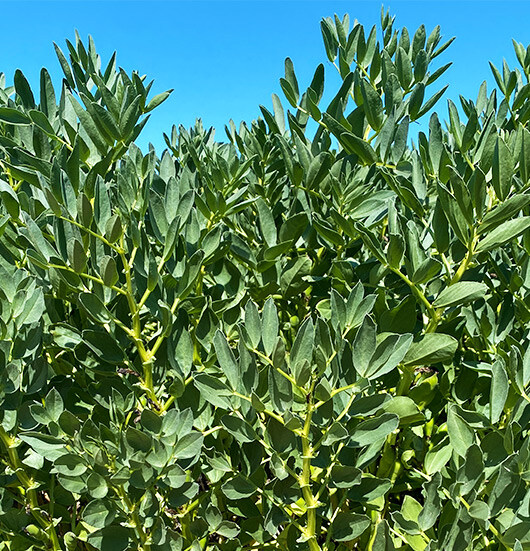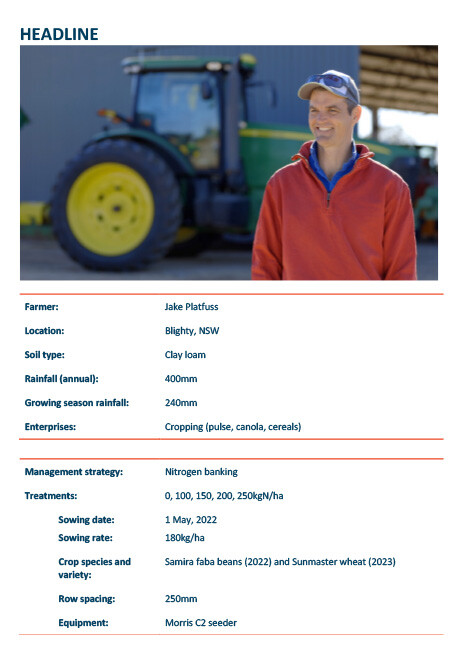Case Study: N Banking and faba beans with Jake Platfuss
Jake Platfuss shares his experiences with soil testing and topdressing faba beans, to improve outcomes for the following wheat crop.

Publication date
15 Nov 2024
Publication partner
This project publication is supported through funding from the Australian Government’s Future Drought Fund Drought Resilient Soils and Landscapes Grants Program and is co-funded by the Grains Research and Development Corporation.
This case study was compiled by Southern Growers.
OPTIMAL SOIL AND WATER MANAGEMENT INCREASES DROUGHT RESILIENCE — FROM THE PLOT TO THE PADDOCK
Drought is an inevitable part of farming in Australia, but outcomes from the Improved drought resilience through optimal management of soils and available water project are equipping farmers with a host of additional strategies with which they can prepare for the inevitable.
Numerous small-scale field trials across southern NSW have shown that early sowing of slower-maturing crops, diverse legume rotations and nitrogen banking can all increase profitability and productivity by increasing soil moisture availability and preventing carbon and nutrient loss under drought conditions. But proving these practices are profitable on a paddock scale is key to ensuring grower adoption.
Using on-farm demonstrations, this project has demonstrated how farmers can apply the theoretical strategies profitably on a paddock scale, across different soil types, environments and land uses.
Riverine Plains led this Southern NSW Drought Resilience Adoption and Innovation Hub project, in partnership with FarmLink Research, Central West Farming Systems and Southern Growers, Charles Sturt University (CSU), CSIRO and the NSW Department of Primary Industries. This collaboration saw management strategies that had been tried and tested by researchers, over six years on four sites, validated on farm with growers and advisors.
The project was supported through funding from the Australian Government’s Future Drought Fund Drought Resilient Soils and Landscapes Grants Program and is co-funded by the Grains Research and Development Corporation.
MEASURING RESIDUAL NITROGEN AND ‘BANKING’ IT IN THE SOIL
Nitrogen banking (N-banking) is a strategy that involves maintaining consistently high soil nitrogen levels regardless of seasonal yield forecasts, thereby reducing the yield gap caused by nitrogen undersupply.
Case study with Jake Platfuss
Location: Blighty, NSW
Soil type: Clay loam
Rainfall (annual): 400mm
Growing season rainfall: 240mm
Enterprises: Cropping (pulse, canola, cereals)
Management strategy: Nitrogen banking
Treatments: 0, 100, 150, 200, 250kgN/ha
Sowing date: 1 May, 2022
Sowing rate: 180kg/ha
Crop species and variety: Samira faba beans (2022) and Sunmaster wheat (2023)
Row spacing: 250mm
Equipment: Morris C2 seeder
AT A GLANCE
- Although grower confidence in pulses, such as faba beans, is traditionally low, they provide a valuable role in the cropping rotation not only as a disease break and an integrated weed management tool, but for their ability to build a nitrogen bank in the soil for subsequent cereal crops.
- Trials have shown that pulse yields can be improved significantly through strategic nitrogen fertiliser application.
- Regular soil tests help farmers calculate the optimal nitrogen application rates to promote yields in the immediate pulse crop and build a nitrogen bank.
With nitrogen one of the single biggest input costs, and availability of nitrogen often being challenging early in the season, farmers are unsurprisingly risk-adverse when it comes to applying fertiliser. But recent on-farm trial results indicate regular soil testing can mitigate a significant amount of the risk of over or under applying nitrogen and incorporating pulses into the rotation can offer additional savings.
Historically faba beans have been viewed as ‘failure beans’ by farmers across the southern NSW irrigation area, but results from a GRDC-funded project coordinated by Southern Farming Systems where yields increased exponentially following the topdressing of faba beans, has seen a renewed interest in the crop.
“With interesting, and sometimes large, increases in yield, farmers wanted to understand how much nitrogen is being pulled from the soil during the pulse rotation,” explained Southern Growers Executive Officer Stephanie Chappell.
“Conversations with our young farmers group provided a resounding yes to finding out more, and we jumped at the opportunity to be involved in the Improved drought resilience through optimal management of soils and available water project to better understand and find the answer to this question.”
Blighty grower, Jake Platfuss, has personal experience with the long-term benefits of including pulses in his rotation, having included a pulse — predominately faba beans — in his irrigated winter crop rotation (pulse, cereal and cereal), for the past 10 – 15 years.
And while he’s seen the benefits to the crop following the pulse phase, he wanted to quantify the amount of nitrogen he was getting in the system and try to increase the input through the pulse crop, carrying it forward for the next three crops, ultimately translating into higher yields.
“An earlier GRDC-funded project showed there was no additional yield response — on irrigated cereals — to nitrogen in a single season when more than 200 units of nitrogen was applied,” Jake said.
“But we wanted to push the system and so have trialled four different rates of nitrogen to see what translates into yield.”
Stephanie explained that wheat crops generally extract only 20 – 40% of their nitrogen requirements from fertiliser, with the balance obtained from the nitrogen ‘bank’ in the soil profile or the mineralisation of organic nitrogen during crop growth.
“Research has shown that less than half of the nitrogen fertiliser applied is taken up by the crop during the year of application,” she explained.
“This means the fertiliser the crop doesn’t use during that season is deposited into the soil’s nitrogen bank for use by future crops, helping to maintain soil fertility, which is particularly important in continuous cropping systems.”
Jake’s on-farm trial of varying nitrogen application rates set out to test this theory.
BOOSTING THE NITROGEN BANK
In 2022 Jake topdressed his irrigated faba bean crop during mid-August, but a wet October (200 – 250mm rainfall) saw the crop fail, with yields dramatically reduced, due to severe disease. This meant no yield response was seen in any of the four treatments across the paddock.
“We also green manured a strip across the paddock mid-flower to try and measure any differences in carryover nitrogen versus the rest of the paddock that was harvested, but due to the flooding not much grain was removed from the paddock probably negating much of the difference between the two,” Jake said.
“We did soil tests during the season to see how the nitrogen moved and accumulated in the soil profile throughout the season under irrigation,” Jake said.
“The tests were taken before each irrigation in spring to try and see what accumulated through mineralisation. The results where a bit messy due to what the crop was using at the time.”
“Essentially the more nitrogen we applied, the more was carried through to the next season, which is what we would expect to see, and what we were hoping to confirm.”
Table 1 shows the soil test results for the paddock in 2022 and 2023.
The wheat crop was fully irrigated and had no moisture stress at any stage so any normal moisture saving following a dryland pulse had no impact here.
TABLE 1. SOIL TEST RESULTS – 2022 AND 2023, BLIGHTY, NSW.
| SAMIRA FABA BEANS (2022) | SUNMASTER WHEAT (2023) | ||
| Urea application rate (kg N/ha) |
Post-harvest nitrogen (kg N/ha) (0–90cm) |
Pre-sowing nitrogen (kg N/ha (0–90cm) |
Post-harvest nitrogen (kg N/ha (0–90cm) |
| Control | 112 | 121 | 180 |
| 100 | 77 | 159 | 376 |
| 150 | 133 | 258 | 191 |
| 200 | 85 | 159 | 183 |
| 250 | 112 | 221 | 172 |
Table 2 shows the yield results for 2022 and 2023.
“We exceeded our target yields of 9 – 10t/ha in the 2023 wheat crop and protein levels were in the 11 – 11.5% range, indicating we didn’t leave any yield on the table,” Jake said.
Protein in the wheat harvest was highest in the 100kgN/ha treatment at 11.5%, with the lowest protein recorded in the treatment with nitrogen applied at 250kgN/ha (11.1%). The control rate (0kgN/ha) and the application of 200kgN/ha recorded protein levels of 11.3%, while the application of 150kgN/ha had a protein level of 11.2%.
“I would have expected to see a larger variation in protein levels between the different treatments — I don’t have any explanation for the smaller-than-expected variance,” Jake said.
TABLE 2. YIELD RESULTS — 2022 AND 2023, BLIGHTY, NSW.
| CROP + TREATMENT | YIELD (T/HA) |
| Samira faba beans | 2022 |
| Control | 2.00 |
| 100 (kg N/ha) | 2.20 |
| 150 (kg N/ha) | 1.80 |
| 200 (kg N/ha) | 1.80 |
| 250 (kg N/ha) | 1.85 |
| Sunmaster wheat | 2023 |
| Control | 11 |
| 100 (kg N/ha) | 11.00 |
| 150 (kg N/ha) | 11.36 |
| 200 (kg N/ha) | 11.68 |
| 250 (kg N/ha) | 10.64 |
LOOKING TO THE FUTURE
Jake believes there is merit in topdressing faba beans and is keen to continue to ‘experiment’ and expand the practice across his broader cropping program.
“The trials probably haven’t shown what the optimal application rate is just yet,” he said.
“But our regular soil testing has shown that the more nitrogen we apply in the pulse phase, the more we can carry forward.
“We need to repeat the trial in the bean crop — without flooding and disease impacting yield — to get some solid yield increases and ultimately determine the optimal nitrogen application rate.”
“Practical and on-farm projects, such as the Improved drought resilience through optimal management of soils and available water showcase the longer-term benefits of management practices,” Stephanie said.
“Farmers are hesitant to grow, let alone topdress, faba beans as they haven’t been viewed as a valuable crop. We need farmers to understand the importance of the pulse in the system and include them in their rotations.”
“But not all farmers are doing this, with many still sowing canola, wheat, wheat. We want them to grow the pulse for the organic nitrogen, but there’s a blockage somewhere.”
“If we can prove the longer-term benefits, backed by science and statistics on irrigation country, removing the blockage in the adoption pathway, we should see an increase in the number of farmers including a pulse in their rotations.”
Resources
See more case studies and videos from the Improved drought resilience through optimal management of soils and available water project
NEWS
Discover unique perspectives on agriculture from across the Riverine Plains.
-
Livestock
-
People
-
Grains
-
Sustainability

